Community Health Profile
Coquitlam
Community Health Profile
Coquitlam
This report provides an overview of health and wellness in Coquitlam that will give residents, community agencies and local governments a better understanding of the factors influencing health in their community. Our hope is that this information will help spark community level dialogue on actions to create health promoting environments and reduce health inequities.

Highlights
- Chronic conditions were lower in Coquitlam compared to the Fraser Health average. Yet, there is room for improvement with respect to healthy behaviours. One in ten respondents reported smoking, less than four out of ten were physically active, less than one in four were eating 5+ servings of fruits and vegetables, and around half had high screen time.
- Driving and long commute times can increase the risk of obesity. Around two-thirds of Coquitlam respondents reported one-way commutes longer than 30 minutes, and few reported walking or cycling to work or to run errands.
- Over 85% of Coquitlam respondents had a family doctor.
- Coquitlam is part of the new Tri-Cities Healthier Communities Partnership where mental health, seniors and physician recruitment have been identified as priority areas.
Community Demographics

Healthy Behaviours
Healthy behaviours contribute to maintaining physical and mental health, and reducing the risk of chronic conditions such as heart disease, diabetes and stroke. Recommended lifestyle behaviours include (but are not limited to) consumption of 5 or more servings of fruits and vegetables per day, limiting harmful alcohol consumption, avoiding smoking, exercising moderately to vigorously for 150 or more minutes per week, and reducing screen time and other sedentary activities.
Healthy behaviours are shaped by individual choices, social and economic conditions and neighbourhood design. Community programs and policies can encourage and enable healthy behaviours and reduce the burden of chronic conditions in our communities.

Across Metro Vancouver
- Canadian born were more likely to be physically active and eat 5+ daily servings of fruits and vegetables, but were 2 times more likely to be smokers compared to immigrants.
- Healthy behaviours were higher among people with annual household income $120,000+. They were 75% less likely to smoke, were 60% more likely to consume 5+ daily servings of fruits and vegetables and were 30% less likely to have 2+ hours of daily screen time compared to those with household income under $40,000.
- Healthy behaviours were higher among university graduates compared to those with less than high school education. They were 80% less likely to smoke and 2 times more likely to consume 5+ daily servings of fruits and vegetables.
- Healthy behaviours varied by ethnicity. Compared to the Metro Vancouver average, smoking was 3 times higher among Aboriginal people, consumption of 5+ daily servings of fruits and vegetables was 40% lower among South Asians, and weekly recommended physical activity was 25% lower among Chinese.
Built Environment
The physical environment in which we live, work and play impacts our health. Physical components of a built environment include neighbourhood design, transportation networks, natural environment, healthy food systems and housing. Community design influences community connectedness, mental and physical health, and chronic disease outcomes by promoting healthy behaviours such as walking or cycling. Healthy built environments are a shared responsibility and require the combined efforts of community agencies, health and social services and various levels of government.
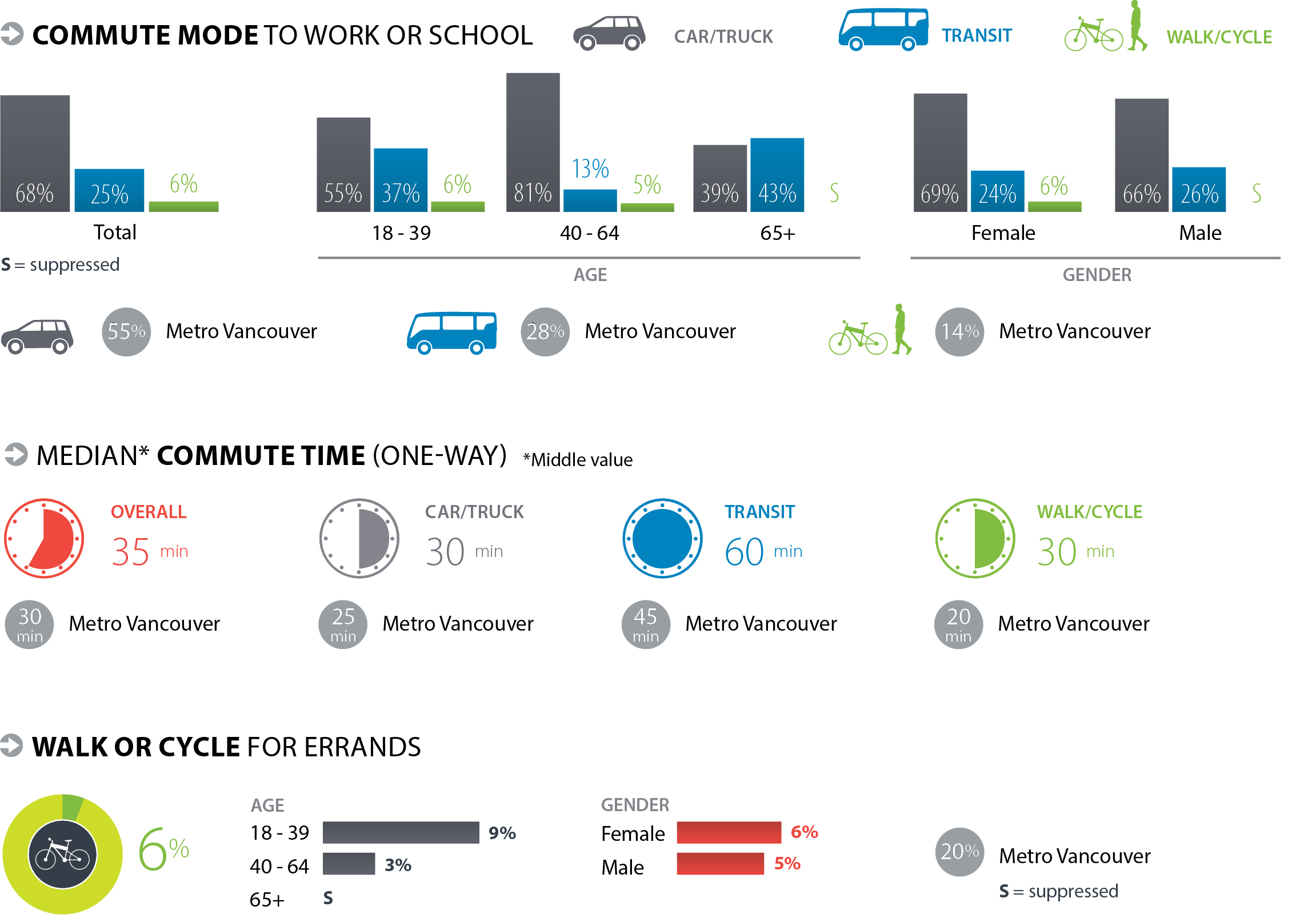
Across Metro Vancouver
- Compared to Canadian born, immigrants and especially recent immigrants were more likely to take transit. Car use among immigrants increases with length of time in Canada.
- Households with annual income under $40,000 were 3 times more likely to commute by transit, 2 times more likely to walk or cycle to run errands, and 2 times more likely to be exposed to second hand smoke in public places compared to household income of $120,000+.
- Commuting by transit was 50% higher among those with less than high school education compared to university graduates. Exposure to second hand smoke in public places was 40% lower among university graduates compared to those with less than high school education.
- Among all ethnicities, Caucasians and South Asians were most likely to drive to work or school. Aboriginal people and Chinese reported the highest likelihood of exposure to second hand smoke in public places.

Community Resiliency
Support from families, friends and communities is associated with better health as it helps people deal with challenges and overcome problems. Supportive communities provide environments in which people are able to make decisions to improve their health and engage in healthy behaviours.

Across Metro Vancouver
- Recent immigrants were less likely to report a strong sense of community belonging, and Canadian born were more likely to report having 4+ people they can confide in.
- Those with annual household income of $120,000+ were more likely to report a strong sense of community belonging and having 4+ people to confide in.
- University graduates were more likely to report having 4+ people to confide in, but were less likely to report a strong sense of community belonging compared to those with less than high school education.
- Compared to the Metro Vancouver average of all ethnicities, Caucasians were more likely to report having 4+ people to confide in, and South Asians were more likely to report having a strong sense of community belonging.
Family Doctor
Having a family doctor plays an important role in maintaining health and preventing chronic illness. Regular contact with a health care provider ensures that recommended preventive services, like screening for early stages of disease, is timely and that chronic conditions are well-managed to prevent complications. Having a regular care provider also helps to maintain continuity of care.
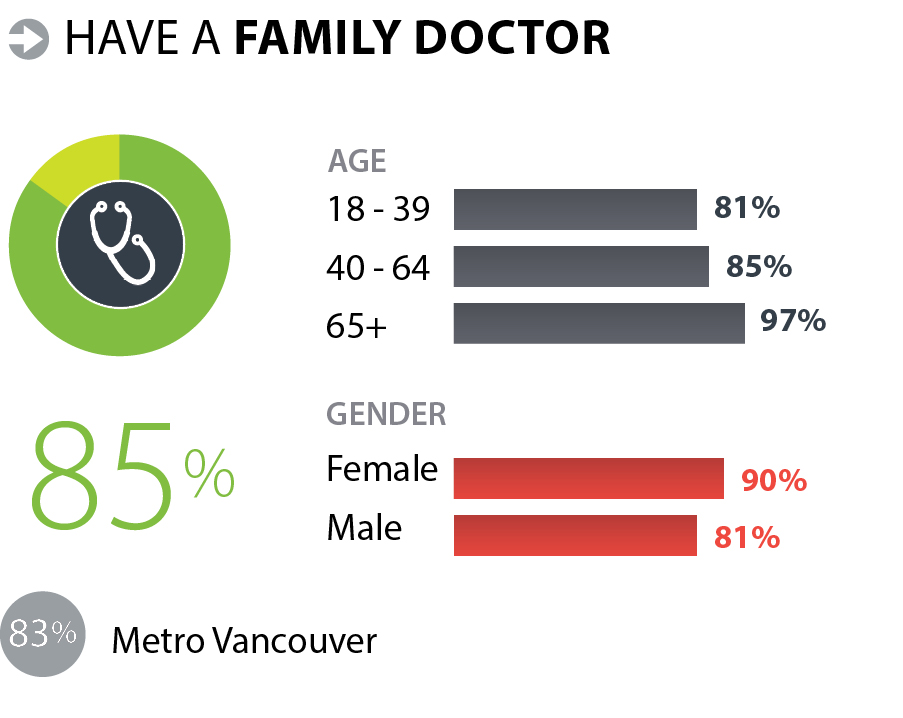
Across Metro Vancouver
- Compared to the Metro Vancouver average, having a family doctor was 25% lower among recent immigrants.
- Households with annual income of $120,000+ were 15% more likely to have a family doctor compared to those with household income under $40,000.
- Among all ethnicities, Aboriginal people were least likely to report having a family doctor and South Asians were the most likely.
Health Status
Our physical and mental health is influenced by lifestyle behaviours, access to health services, the built environment, and our social and economic situation. Self-rated health is considered to be a good measure of the general health status of a population.
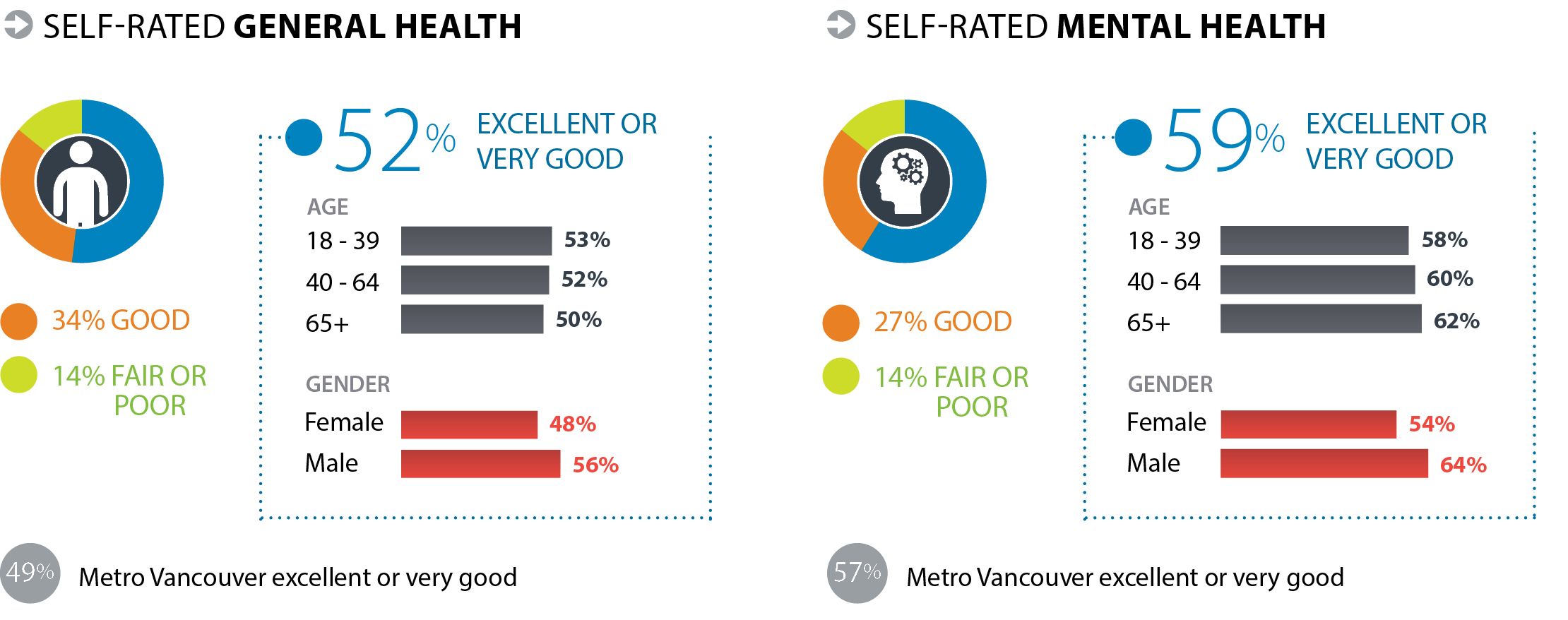
Across Metro Vancouver
- University graduates were 2 times more likely to report excellent or very good general health and 60% more likely to report excellent or very good mental health compared to those with less than high school education.
- Households with annual income $120,000+ were 2 times more likely to report excellent or very good general health and 60% more likely to report excellent or very good mental health compared to households with income under $40,000.
Obesity
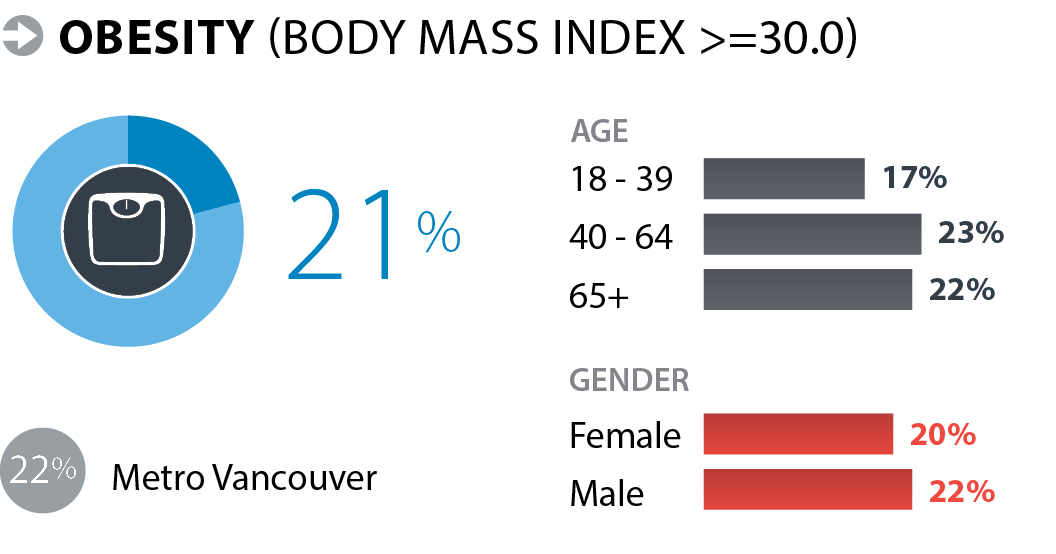
Across Metro Vancouver
- Obesity was lowest among university graduates compared to all other educational levels.
- Compared to the Metro Vancouver average of all ethnicities, obesity was 60% lower among Chinese and 55% higher among Aboriginal people.
Self-reported Chronic Conditions
Chronic conditions are a major burden on our health care system, individuals, families and communities. Strategies to prevent chronic conditions include the development of policies and programs, at a community level, which encourage and enable healthy behaviours in order to reduce risk factors for chronic conditions.
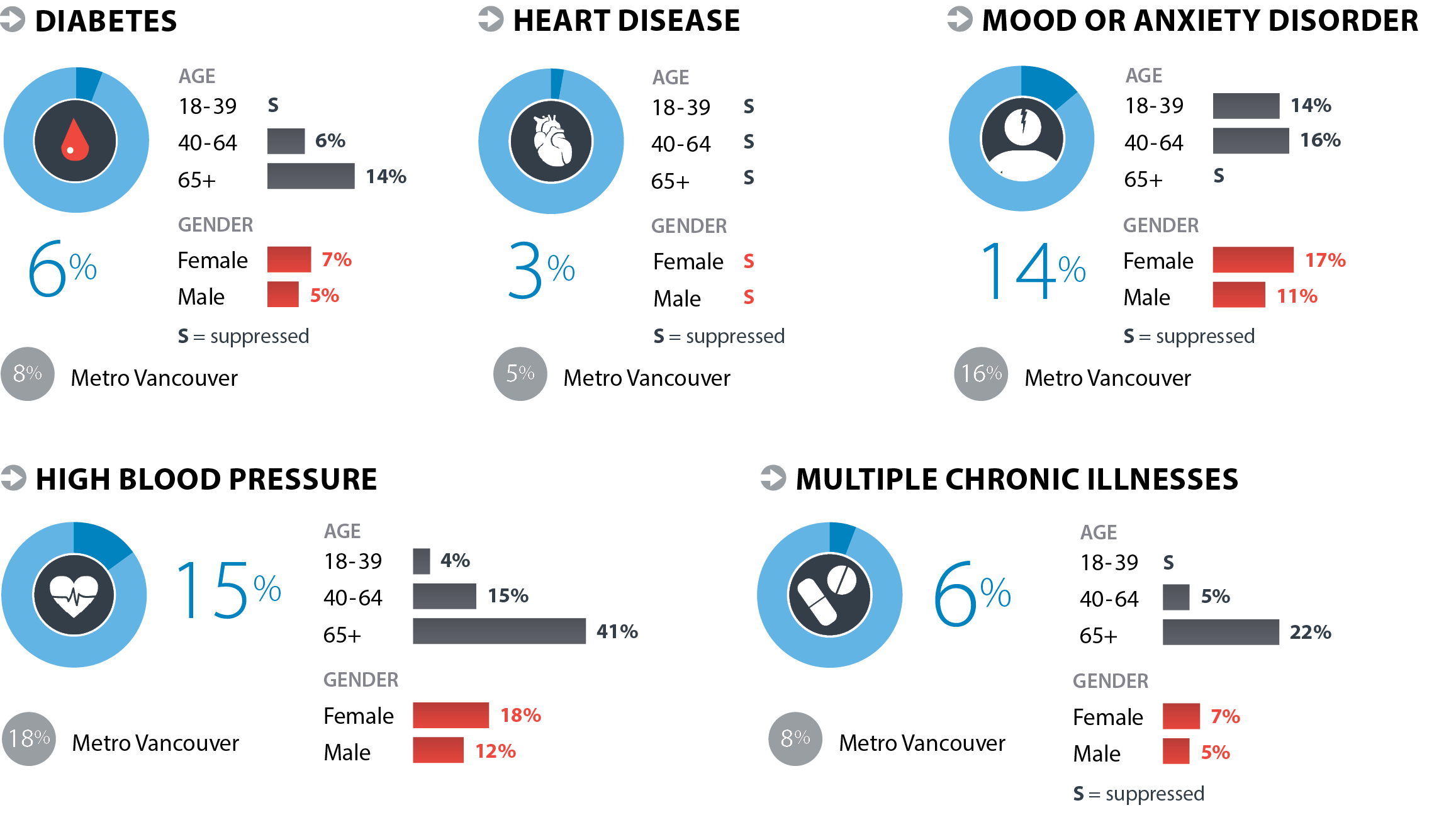
Across Metro Vancouver
- Multiple chronic conditions were 4 times higher among those with less than high school education and 3 times higher among those with annual household income under $40,000 compared to those in the highest income and education groups.
- Self-reported chronic disease burden varied by ethnicity. South Asians were more likely to report diabetes, heart disease and multiple chronic diseases. Visible minorities were least likely to report mood or anxiety disorder.
